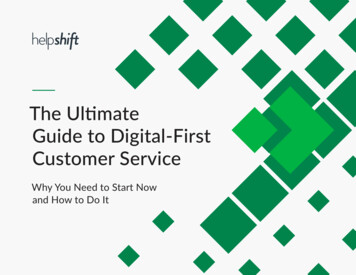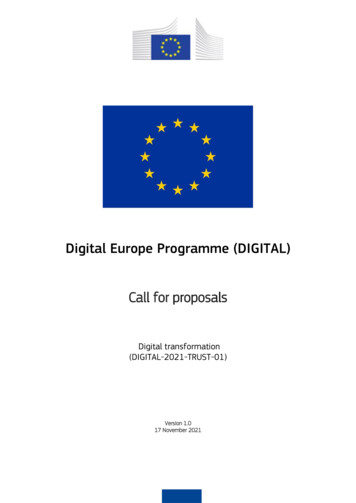
Transcription
The UltimateGuide to Digital-FirstCustomer ServiceWhy You Need to Start Nowand How to Do It
Table of Contents03What You Can Expect From This Guide04Digital Transformation Reaches the CustomerService OrganizationThe Growing Preference for Digital-First InteractionsNew Channels Emerge to Meet Consumer Demands07The False Promise of Omnichannel as YourDigital-First Anchor29It’s Time to Level Up Your Digital-First CustomerService StrategyEvaluate the Maturity of Your Support OrganizationExpected Results: The Payoff of Automating38Take Your First Steps Toward Digital-FirstCustomer Service45Next Up: Further Enhance Your Digital Channelswith AutomationSiloed Experiences Lead to a Disconnected Customer JourneyAn Example Customer Journey with Five BotsExperience is Built for the Brand, Not For the ConsumerStart Building Your Own Bots11Missing Piece in Transforming to Digital-First: ConnectedConsumer ConversationsCreating a Connected CX StrategyWorksheet: Lay the Groundwork for Digital-First Customer Service56The Secret Ingredient: An Asynchronous ApproachA Deeper Dive into Using AI, Automation and DigitalChannels TogetherInternal-Facing People Improvements Delivered by AI and BotsIntegrating AI and Automation for Greater EfficiencyThe Financial Impact of AI and Bots16Prepare Your Team for Next-Generation Customer ServiceMessaging: One Channel to Bridge them AllThe Connecting Power of Messaging for CustomersThe Connecting Power of Messaging for Contact CentersEnhancing Phone through Messaging60This Isn’t the Conclusion. It’s the Beginning of YourDigital-First Customer Service JourneyThe Ultimate Guide to Digital-First Customer Servicehelpshift.com2
What You Can Expect From This GuideIt’s quite likely that the majority of your customers contact your customer service (CS) organization through digitalchannels. Since they’re looking for support via digital, you need to be available and responsive in these channels.But do you know which digital channels to prioritize?While many customer service organizations have adopted an omnichannelInside this guide, you will find all the context, worksheets, infographicsapproach, this strategy falls short in two key ways: it creates siloed,and data-driven analysis that you need to get started with effective digital-firstdisconnected experiences for the consumer, and the channels that are usedcustomer service.most frequently cause long wait times and operational inefficiencies.Since you may want to focus on specific topic areas, we wrote this guide usingIf your contact center is not yet offering support via messaging and bots,a modular approach. We cover the topic in-depth and from multiple anglesit’s time to rethink your strategy. These customer service channels — andso you will walk away with a thorough understanding of digital-first customerthe tools that support them — enable brands like yours to satisfy consumerservice and how to chart your own course. If your organization alreadyexpectations for convenient support and speedy issue resolution whilerecognizes the need to adopt a digital-first CS strategy, you can skip the earlyboosting agent productivity and reducing costs.sections that focus on justifying such a strategy and jump right into learninghow to get there — just begin your reading on page 14 at the start of theThe focus on messaging and bots is a new way of thinking about customerservice to create a fluid, connected experience for the consumer — and thatis precisely the driver behind the creation of this guide. This guide will helpyou understand the unstoppable evolution toward digital-first customerservice, and how you can equip your company and agents to deliver thecustomer experience (CX) that sets today’s winning brands apart. We’re goingto guide you through it step by step and make it a tangible strategy you canactivate within your own customer service organization.section entitled “Messaging: One Channel to Bridge them All.”
Digital Transformation Reaches the CustomerService OrganizationBrands know they can’t compete with the likes of Amazon and Uber when it comes to pricing, product assortment,or supply chain excellence. But leading brands recognize the opportunity to differentiate by delivering the best customerexperience possible. And they’re realizing that vision by digitally transforming their customer service organization.Nearly 90 percent of company leaders view customer experience (CX)No wonder two-thirds of the CEOs of Global 2,000 companies are planningas a competitive differentiator, according to the 2019 Global Customerto adopt modern digital strategies to improve the customer experience beforeExperience Benchmarking Report.the end of 2019. And the impact will be widely felt. Gartner estimates that 85percent of all customer interactions will be managed without a human by 2020.This revolution in customer service is being driven by three key factors—newtechnologies like Artificial Intelligence (AI), the ubiquity of digital channels,Do you view customer experience asa competitive differentiatorand consumer demand for faster, more convenient and consistent customerservice. You can take advantage of this revolution to set your organization apart.Customer Services — B2C88.8%YesNoNot Sure6.6%4.6%85%Gartner predicts that by 2020, “customers will manage85 percent of their relationship with the enterprisewithout interacting with a human.”% responsesThe Ultimate Guide to Digital-First Customer Service2019 Global Customer Experience Benchmarking Report (c) Dimension Datahelpshift.com4
The Growing Preference for Digital-First InteractionsThere’s no question that customers are empowered by technology, and areusing that empowerment to get what they want, when and how they want it.More than half of all consumers now expect a customer service responsewithin one hour — not only during business hours, but around the clock,including nights and weekends.This paradigm shift to real-time, any-time gratification is compelling customerservice organizations to make themselves accessible and on-demand on a62%Over six in ten consumers needed to make multiple contactsto resolve their most recent customer service need.24x7 basis. Fail to do so and they risk making a large portion of their customerbase feel undervalued. That’s reflected in the 66 percent of online adults inthe U.S. who say that the most important thing a company can do for themis to value their time by providing a good online customer experience.Unfortunately, too many companies fall short when it comes to the customerservice experience. Nearly 1 in 3 customers report difficulty reaching customerservice, 6 in 10 need to contact customer service multiple times to resolvetheir issues, and only 46 percent say their issue was resolved within an hour.46%Only 46% of consumers reported resolution of theircustomer service need within an hour. Almost one in tenindicated their problem was never resolved.29%One in three consumers report that it was difficultcontacting a business when trying to handle their lastcustomer service need.Source: ustomer-experience-2018-report/The Ultimate Guide to Digital-First Customer Servicehelpshift.com5
New Channels Emerge to Meet Consumer DemandsLet’s first review the most common customer service channels, along with their pros and cons:PhoneSocial MediaThanks in large part to legacy systems and the acceptance of phoneMany companies establish dedicated customer service social pagessupport by the Boomer and Silent generations, phone still makes up the(usually on Twitter) in an effort to minimize negative exposure and helpmajority of customer service interactions. The pros of the phone includeresolve customer issues. But social media is not reliable and predictablesupporting customers who need urgent assistance. But the phone hasenough to serve as the foundation for a customer service strategy.major disadvantages. Long wait times can easily irritate customers,Messaging apps via social media such as Facebook Messengerand the need for agents to work on one issue at a time makes thecan be more reliable.process inefficient. Plus, keep in mind that live phone conversationsfor customer service interactions are rapidly falling.EmailLive ChatMost companies start out using email for customer service, but quicklyMany messaging-based strategies include some level of live chat forcome up against scalability issues. Agents end up dealing with a clunkyVIP/loyalty customers, urgent issues, or tickets that are escalated fromUI and ticket backlog, while customer satisfaction drops because ofa bot. However, it’s hard to scale live chat when serving a large numbera lack of live responses and slow turnaround times.of customers, and they can end up waiting in a queue for an agent.In reality, many companies thought that an omnichannel approach would be the ideal way to service the modern customer but now recognize that they do noteven use all these channels. To fulfill brands’ desire to modernize, a smarter approach leverages the selective application of digital-first technologies and AI to providea fully-connected customer service journey across channels.The Ultimate Guide to Digital-First Customer Servicehelpshift.com6
The False Promise of Omnichannelas Your Digital-First AnchorThe omnichannel mantra dictates that you be in every channel where your customers exist. But just being in every channelis not a strategy. It’s a tactic that often proves unnecessary and expensive. Instead, you should think through yourapproach to each channel before deciding on which to support.Look at it this way: Customers don’t express a desire to meet with brands viaThe important thing is to choose the channels that enable the optimal blendphone, email, chat, etc. Instead, first and foremost, they want a conversationalof customer experience, agent experience, overall customer service excellence,and convenient experience with minimum barriers to resolution. But that’sand operational efficiency.precisely where omnichannel often stumbles.With omnichannel support, companies find it difficult to connect the differentmodes of communication. When disconnects occur, customers are forced tostart over and repeat themselves with each new chat, email, or call. They growfrustrated and feel their time has been wasted, while company resources getdrained quickly. It’s a lose-lose proposition. It’s in your best interest to avoidsuch isolated and broken experiences at all costs, which is why leading withomnichannel as an overarching strategy is both expensive and superfluous.
Siloed Experiences Lead to a Disconnected Customer JourneyCustomer service happens on all the platforms that consumers useThink about the experience from your customers’ perspective — it’s veryto communicate with one another — traditional phone calls, email, chat,disconnected. The consumer can't continue a conversation from channelsocial media. But — no matter why they are contacting customer support —to channel or from self-service to a channel. Plus, the agent doesn't haveconsumers experience much more frustration communicating witha full view into the customer journey to date.customer service across these channels.When they call their best friend, consumers are not put on hold or transferredSiloed experiences lead to a disconnected customer journey. Withfrom person to person. When your customers message a friend they haven’tomnichannel, the idea was to start adding channels, keeping self-serviceconnected with in a while, the conversation doesn’t disappear if the friendseparate. Support teams started layering on email, live chat, social, phone —takes hours to respond. Consumers have developed expectations of thesewith all of these channels being agent-powered. When customer servicecommunication channels based on their personal experiences — and theyteams wanted to incorporate bots, they added them to help with self-service —expect customer service organizations to satisfy them too.but did not embed this functionality across channels or carry over context.This has still resulted in a disconnected customer experience becauseall the elements are siloed.
The Promise of Omni-ChannelDifficult to Navigatefor the ConsumerUnifiedfor the Agent
Experience is Built for the Brand, Not For the ConsumerThe omnichannel promise unified the experience for the agent. But that's notHowever, both email and live chat presented new problems.good enough. In the image on the previous page, you see how the experienceis broken for the customer.It’s challenging to staff for live chat because it requires significant manpowerto scale. On the plus side, agents can handle roughly two simultaneousOver the past decade, customer service has progressed from a nearly soleconversations with live chat on average. However, these agents are tetheredreliance on call centers to incorporating a variety of technologies such asto those two conversations and can’t escape the wasteful downtime whileemail, live chat, and social media messaging. With these new digital channels,awaiting customer responses.customer service enjoys greater scalability while delivering an increasinglyuser-friendly experience for both consumers and agents.From a customer experience perspective, live chat’s lack of persistenceThe introduction of email and live chat meant customers no longer had toa chat window or tab, or leaves for more than five minutes, the conversationwaste precious time on hold or being bounced from agent to agent to solvehistory is lost. The customer is forced to restart the conversation — a frustratingtheir problems. Using these technologies, organizations can enable theirexperience — and will most likely sit around until the issue is resolved to avoidagents to handle multiple inquiries simultaneously rather than be restrictedanother frustration.presents a significant problem. If a customer inadvertently closes out ofto 1-1 phone communications.Email introduces the opposite problem. It can be cost-effective to staff foremail, but the time lag in responses can frustrate customers and agents alike.Time to resolution can take days — and that’s simply unacceptable in anon-demand world. For digital-native brands, this can result in churn —from both customers and agents.helpshift.com10
The Missing Piece in Transforming to Digital-First:Connected Consumer ConversationsOmnichannel is a platform for your team, with all agent functionality and all channels accessible from the agent dashboard.It’s connected for your agents. But what we haven't seen is a connected channel experience for your customers.
Creating a Connected CX StrategyWhat it takes is a unifying experience that connects all communicationOnce again, brands look to modern communication.channels, as well as self-service and bots for the full journey, for yourcustomers. With a connected channel experience, your customers can seeBrands needed a way to enable ongoing conversations — whether their agentstheir conversation history, pick up the conversation where they left offwere available to respond instantly or not. They needed the conversationaland not have to repeat themselves across different channels.interface of live chat and the persistent nature of email. They also neededa way to deliver an experience that would not force customers to wait on holdor repeat themselves. Of course, it also had to be cost-effective to staff.Bots & AISocial messagingIOT &physical goodsSelf-servicePhoneNew!Messaging 9?( ,-/% Connected Consumer Conversations
The Secret Ingredient: An Asynchronous ApproachEnter asynchronous messaging — the communication format that consumersAt the most basic level, asynchronous communication is time-lapsed whilealready use and love on their smartphones with today’s messaging appssynchronous communication happens in real time. We often flow between the(WeChat, iMessage, WhatsApp, etc.). These apps are all async-enabled,two in our daily lives, for example, sometimes chatting in real time, and otherwhich is the best way to communicate and capture the benefits of emailtimes responding at our convenience much later.and chat — without all the associated costs.Asynchronous communication represents the way consumers interact withone another on messaging platforms. They can engage in a fluid, ongoingconversation that does not rely on immediate responses. We tend to rely heavilyJust consider the growing popularity of these messaging platformsfor consumer to consumer interactions: There are nearly 4 billion global active users of messaging apps U.S. smartphone users are sending and receiving five times asmany texts than phone calls each day The top 7 apps in the world in terms of frequency of use are allmessaging appson this type of communication every day. Think about sending an email in themorning and not receiving a reply until the afternoon or the next day. We mightwait until after work to respond to a group text, and answer Slack messagesafter finishing an important project.Asynchronous messaging is completely disrupting communication. We havedefinitively entered the era of messaging with the skyrocketing popularity ofplatforms such as iMessage, Whatsapp, Slack, and WeChat. What makes thesechannels so popular? It’s the convenience of having an ongoing conversationwithout both parties necessarily being available in the moment.Unlike live chat, which is dependent on conversations happening in realAsynchronous-enabled communication (aka async-enabled) solves thetime (synchronous), most consumer communication is now async-enabled.disconnect problem that occurs when your customer service organizationThrough async-enabled communication, consumers can access full chattries to connect different channels of communication. To understand howhistories and seamlessly transition between live and lapsed communication.it does that, first we need to explain what async-enabled communicationis and how it’s different from synchronous communication.This is why communications have overwhelmingly evolved tobecome asynchronous.The Ultimate Guide to Digital-First Customer Servicehelpshift.com13
Messaging is ideal because it’s perfectly suited to the ebb and flow ofThe conversational nature of messaging allows brands to deliver personalized,combined live and lapsed communication that consumers are used to. It helpsconvenient, and efficient customer service just when a customer needs support.that consumers can access messaging platforms on every device type,In fact, even though messaging does not promote an expectation of immediatefrom mobile phones to computers and tablets.responses, customer service organizations are able to resolve customerinquiries much faster via this channel. No wonder brands score higher CSATsBy enabling messaging for these devices from a UX perspective as well aswith asynchronous messaging than with email. Plus, consumer familiarity withincluding notes and conversation histories on the agent side, brands createmessaging means brands using this channel are in tune with their customers,a messaging experience that is async-enabled from both the consumerand can optimize user experiences at scale.and the agent perspective.The messaging channel is particularly attractive for brands because consumershave been proactively seeking them out via these apps for years. Since 2016,users around the world were logging in to messaging apps to not only chat withfriends but to connect with brands. And they are expressing this desire acrossgenerations. Messaging apps surpassed social media networks in popularityseveral years ago and continue their meteoric rise as consumers make theirpreference for messaging clear.While live chat sets expectations for instantaneous responses andresolution, messaging allows for more fluid dialogue exchanges.By enabling a fluid transition between live messaging andasynchronous messaging, a messaging interface offers the bestof email, phone, and live chat combined. Messaging affords theconvenience of time-lapsed exchanges while providing real-timeescalation to live conversations for urgent/VIP use cases.This optimizes the experience — both on the agent side andthe customer side.
Integrating AI and Automation for Greater EfficiencyThe delivery of fast and efficient asynchronous messaging requires two3. Significant boost to agent productivity with the introduction of botstechnological pillars: AI and automation. When we refer to the use of AI,Bots significantly reduce the number of average agent-sent messageswe’re not talking about the general application of AI which, frankly, has failedper interaction within live chat and asynchronous messaging on the webmany customer service teams. Instead we are referring to the new paradigmand mobile. This frees up each agent to work on more issues withinin which the messaging platform serves as a container that uses AI and botsa given period of time. (More on bots in a bit.)to make asynchronous messaging faster and more effective. For example, theHelpshift platform incorporates AI into asynchronous messaging solely for theAfter launching asynchronous messaging across web and mobile in 2018,purposes of classifying issues and offering knowledge articles. By selectivelybrands are now seeing stunning levels of automation without compromisingincorporating AI and automation into the asynchronous messaging process,customer satisfaction. Read all the ways they’re making this happen.organizations can automate over 50 percent of customer service interactions.Asynchronous messaging delivers three big benefits for brands:1. Much higher CSAT ratings for messaging-based conversations Messaging with 4.1 Live chat with 3.6 Email with 3.3 Web forms with 3.0*CSAT scores, by channel, on a scale of 1 to 545%45 percent of consumers don't care if they interact witha live agent or a chatbot, as long as the solution is quickand effective.2. Ability to automate more than 50 percent of customerservice interactionsIn addition to automating without affecting CSAT, brands thatuse self-service tools like FAQs in tandem with automated workflowsachieve the strongest KPIs.The Ultimate Guide to Digital-First Customer Servicehelpshift.com15
Messaging: One Channel to Bridge them AllTwenty years ago, brands provided customer service either in-person or over the phone. It’s hard to believe but justa few years ago, brands were trying to support consumers with thousands of underpaid, poorly informed agents offeringhit-or-miss resolution to customer issues.Today, many of these same contact centers are using advanced technologies —specifically AI and bots — to collect routine information. In turn, they areemploying fewer — but better equipped — agents who can adeptly handlemore complex issues. While these companies benefit from far moreefficient staffing models, their customers benefit from a stellar customerservice experience.The reason is clear – on agent-assisted digital channels like messaging,customer service can respond much more quickly to customer inquiries.Note the dramatic improvement in response times when using messagingversus email or social media: 18.5 minutes compared to 69.6 minutesvia social media and 411.4 minutes on email.
Do you wish more businesses would use textingto communicate with you?64%76%Baby boomersGen XGen Y82%Gen Z83%Customer service response timesby channelCustomer Services — B2C30Instantmessaging(incl. WhatsApp,SMS)% answered "yes"Web chat(incl. co-browse)What does your organization consider as the topthree benefits of AI and robotic automation?Customer Services — B2C1183.91Social media70.5%47.9%40.8%Improved customerexperienceCost reductionCustomer analytics(detailed data capture)411.4Email1069.6Average (min)Top quartile2019 Global Customer Experience Benchmarking Report (c) Dimension Data% responses2019 Global Customer Experience Benchmarking Report (c) Dimension DataSource: businesses-to-text-them-more-often/
The Connecting Power of Messaging for CustomersBrands are finding it more effective to redirect traffic from traditional channels, like phone and email, to messaging. The main reason? Their customers are alreadythere. As a result, when brands make the shift to messaging, they realize multiple benefits, both for customers and for their own internal operations.Customer service organizations are taking their cues from today’s messaging apps to deliver four major benefits to consumers, simply by allowing them todo the following:1. Return to interactions later:3. Engage in multiple conversations/activities at once:Using notifications and enabling window/browser closure, brands canBeing sensitive to how customers lead multi-tasking lives is important.allow customers to leave a chat for as long as they need and re-enterAsync-enabled customer service messaging helps customers manage theirthe conversation right where they left off – without losing conversationdaily routine without having to work around a brand’s customer servicehistory. Access to conversation history is important to consumers whorestrictions such as business hours.are used to messaging apps like iMessage and Facebook Messengerthat store searchable conversation histories.2. Move to a different device and channel:Adding the flexibility of device-agnostic time-lapsed conversationsmakes the customer experience even more seamless. For example,on-the-go consumers who request customer support in a brand’smobile app can return home, switch to a laptop, and continue theconversation in a browser window.1:30pm2:00pm3:45pmThe Ultimate Guide to Digital-First Customer Service5:00pmhelpshift.com18
When analyzing our customers’ aggregated data, we found that botssignificantly reduce the number of average agent-sent messages perinteraction within live chat and asynchronous messaging. When botsare used, the initial response time is almost immediate, and the timeto resolution is also majorly reduced.Average Agent Outbound Messages/ CaseLive chat2.8AsynchronousMessaging1.42.6Without bot automationsWith bot automations3.9
The Connecting Power of Messaging for Contact CentersAlthough driven by customer needs for a flexible, seamless, and personalizedBy incorporating bots into their messaging strategy, brands enable theirexperience, contact centers also gain substantial operational benefits bycustomers and agents to have more efficient interactions, as customersdeploying asynchronous messaging.can self-serve and bots can collect basic information that informs theagent-customer conversation.The messaging channel is far less expensive to staff and scale than phone calls,live chat, or even email. Plus, brands can support customers in either real timeBased on the numerous and substantial customer-facing and internal-facingor whenever their customer service team has bandwidth, without forcing thebenefits, a growing number of organizations are prioritizing their ability tocustomer to wait online for help. This strategy lets you prioritize urgent issuesmanage an explosion in messaging-based issue volumes.with live support while issuing email and push notifications to other customersonce an agent has responded — bringing them back to the chat at the exactpoint where it was paused.DimensionsLive chatMessagingTime Customers have to be online, and may experience Customers get their time back and don't have to wait on holdlong wait times and poor CX, resulting in 'abandons' Easier to staff Enough agents have to be available in real time, Better agent efficiency (1:3 ) Concurrency capped at 1:2 (Forrester found 1:1.8) Limited to sessions Persistent conversations enriches context Hard to share No repeat of information necessary Repeating information is frustrating Allows personalization and re-engagement Limited to front-end self-service Bots and humans can work together via messaging Self-service is siloed and not connected to agent assistancewhich is hard to staffContextAutomationThe Ultimate Guide to Digital-First Customer Servicehelpshift.com20
Enhancing Phonethrough MessagingPhone will always remain an important channel for very specific and highlyAnticipated impact of AI, robotic automation,and digital transformation on CX operationsin the next two yearsCustomer Services — B2Ccomplex customer issues. Nevertheless, as people continue moving awayIncreaseStay the sameDecreasefrom the voice channel, customer service organizations will de-prioritize itin favor of messaging.Whereas almost 80 percent of consumers age 55 and above prefer the phone,fewer than half of those under the age of 26 want to engage in live phoneRoboticautomationvolumes will.(incl. AI)interactions. This drove live phone conversations down to just 41 percent ofall customer service interactions in 2017. And the gap of digital over phone issteadily increasing. Note the expected decrease in phone and live agent volumeand increase in digital agent-assisted volume over the next two years per the2019 Global Customer Experience Benchmarking Report.Digital agentassisted servicevolume will?Overallinteractions will?(spanning all channels)Telephone/liveagent volumeswill.2019 Global Customer Experience Benchmarking Report (c) Dimension Data90.55.73.810.81221.314.513.720.377.264.366
Why beef up your contact center to handle more phone calls whenBy its very nature, phone is more expensive than messaging since phone-basedGartner predicts that phone conversations with customer service willagents can only engage in one-on-one conversations versus working onaccount for a mere 12% of service interactions by 2022?multiple issues at once.Still, customer service organizations need to support conversations over thephone for a subset of high-touch issues. Even though the phone should stillbe used, messaging helps minimize its usage. Here’s how you should rethink80%voice in this messaging-centric era.Survey Research by Agero found that while nearly 80percent of cons
This revolution in customer service is being driven by three key factors—new technologies like Artificial Intelligence (AI), the ubiquity of digital channels, and consumer demand for faster, more convenient and consistent customer service. You can take adv











